Engine structure
Recently I stumbled upon a wonderful site (English), which grinds and shows the structure of most types of engines. I will try to retell freely and concisely the most important thing in my opinion, completely on the fingers and as for the smallest. Of course, one could borrow exact definitions from reputable sources, but such an amateur translation promises to be one of a kind :)
And can you immediately explain to your girl how the gasoline engine differs from a diesel one? Four-stroke and two-stroke engines? Not? Then I invite under the cat.
')
The working four-stroke engine was first introduced by the German engineer Nikolaus Otto in 1876, since then it is also known as the Otto cycle. But it is still more correct to call it a four-stroke. The four-stroke engine is probably one of the most common types of engines in our time. It is used in almost all cars and trucks.
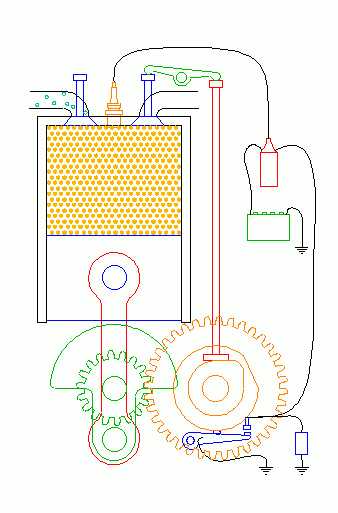
Under the four cycles are meant: intake , compression , stroke , and release . Each stroke corresponds to one piston stroke, as a result of which the working process in each of the cylinders takes place in two revolutions of the crankshaft.
Inlet
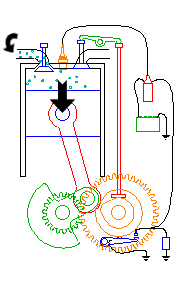
During intake, the piston moves downward, pulling in a fresh portion of the air-fuel mixture through the intake valve. A distinctive feature of the engine in question is that the intake valve opens due to the vacuum generated by the downward movement of the piston.
Compression
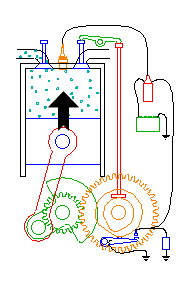
Torque raises the piston, and that in turn compresses the air-fuel mixture. The inlet valve closes with increasing pressure force resulting from the piston lift.
Working stroke
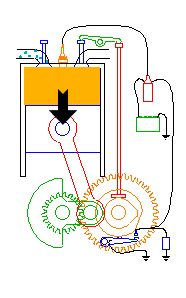
At the top of the compression stroke, the spark ignites the compressed fuel. When fuel burns, energy is released that acts on the piston, causing it to move down.
Release

When the piston reaches its lowest point, the exhaust valve opens and the exhaust gases are expelled from the cylinder by a piston moving up.
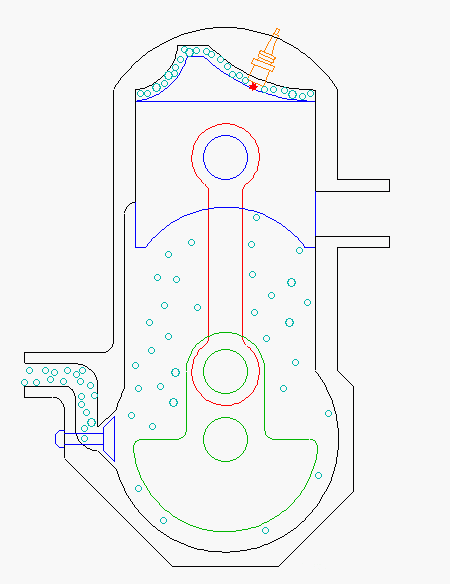
Since in a two-stroke engine, each stroke of the crankshaft has one working stroke - two-stroke engines are always more powerful than four-stroke engines (if we take engines of the same volume). An important factor in favor of the former is their simpler and lighter design. These engines are widely used in benzo-saws, outboard motors, snowmobiles, light motorcycles and aircraft models.
Indisputable drawbacks of this type of engines are their inefficiency, since a significant proportion of the fuel does not burn out and is emitted along with the exhaust gases.
Inlet
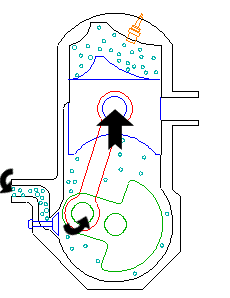
The air-fuel mixture is sucked into the crank chamber due to the vacuum that is created during the upward movement of the piston.
Compression in the combustion chamber
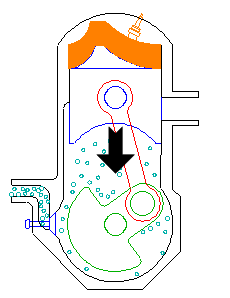
During compression, the intake valve closes with pressure in the crank chamber. The fuel mixture is compressed at the final stage of the stroke.
Movement of the fuel mixture / release

Toward the end of the stroke, the piston forces the compressed air-fuel mixture to move through the intake passage from the crank chamber to the master cylinder. The air-fuel mixture displaces exhaust gases that leave the master cylinder through an exhaust valve. Unfortunately, the cylinder also leaves a certain amount of unburned fuel, which is why the two-stroke engine design is considered less economical.
Compression

After which the piston rises, driven by torque, and compresses the fuel mixture. (At this point, the next intake stroke occurs under the piston).
Working stroke

At the top of the bar, the spark plug ignites the fuel mixture. The energy generated causes the piston to move downward until the end of the cycle. (At this moment at the bottom of the cylinder, the fuel is compressed in the crank chamber).
A feature of the diesel engine is a modified fuel ignition system.
Having created his own type of engine in 1897, Rudolf Diesel declared that his engine is the most efficient engine ever made. Until now, his brainchild is among the most economical engines.
Inlet
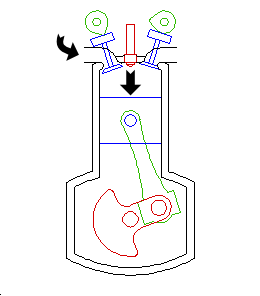
The inlet valve opens and fresh air (without fuel) is sucked into the cylinder.
Compression

When the piston rises, the air is compressed and the temperature in the cylinder rises. At the end of the stroke, the air becomes hot so that the temperature becomes sufficient for the ignition of the fuel.
Injection

Near the top of the compression stroke, the fuel injector injects fuel into the cylinder. Contact with hot air ignites the fuel.
Working stroke
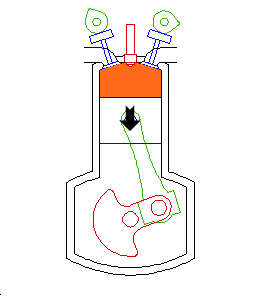
When fuel burns, energy is released that acts on the piston, causing it to move down.
Release
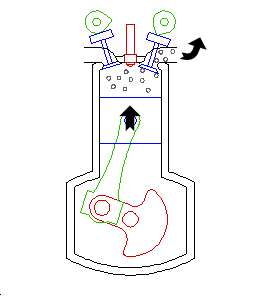
The exhaust valve opens, forcing the exhaust gases to leave the cylinder.
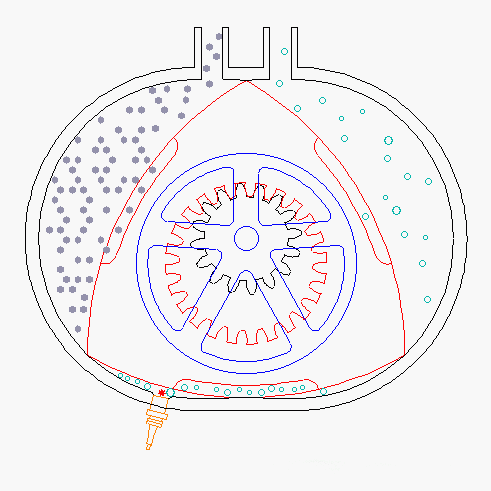
Wankel's rotary-piston engine is an amazing creation, offering a very intricate re-planning of four Otto cycle cycles. It was developed by Felix Wankel in the 50s of the last century.
In a Wankel engine, a trihedral rotor with a ring gear rotates around a fixed gear shaft in an elongated chamber.
Nowadays, Mazda is making the greatest efforts to develop and promote this type of engine, but the four-stroke engine remains the most popular. AvtoVAZ also uses this type of engine in autogyros .
Inlet
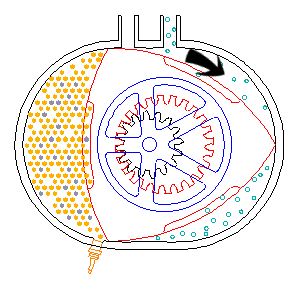
The air-fuel mixture flows through the intake valve at this stage of rotation.
Compression

The fuel mixture is compressed here.
Working stroke
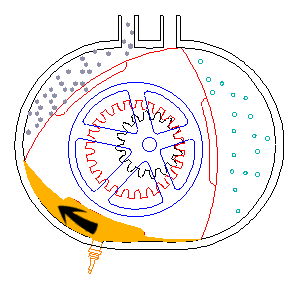
Working stroke, the fuel mixture is ignited here, rotating the rotor in a circle.
Release
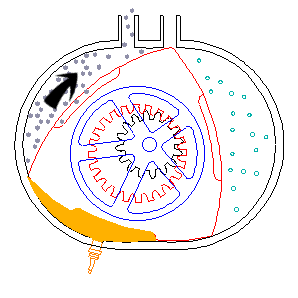
Exhaust fumes come out here.
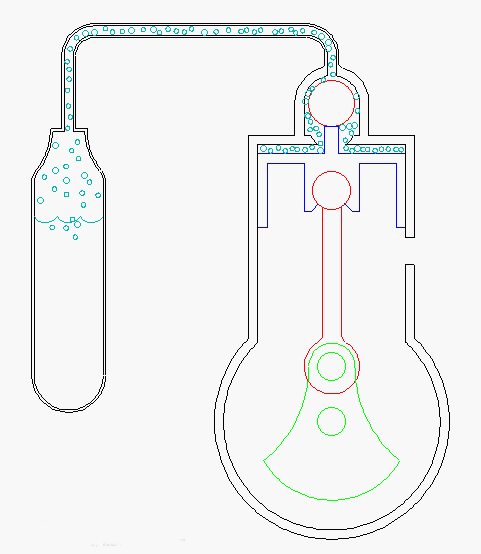
This type of engine can be driven by steam, but more often it can be found in small models of airplanes, where it operates on compressed air or carbon dioxide.
This animation shows a CO2 tank. Compressed CO2 is a liquid that, when released, goes into a gaseous state or in other words - at normal atmospheric temperature and pressure, liquid carbon dioxide boils, therefore we will not be mistaken if we say that this type of engine works for a couple of CO2.
Inlet

At the top of the cycle, the piston pin presses against the ball valve to admit high-pressure gas to the cylinder.
Working stroke

Gas expands moving piston down
Release
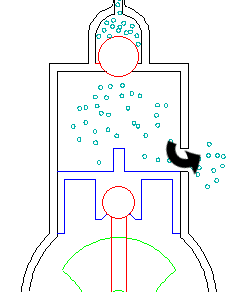
When the piston opens the exhaust valve, the pressurized gas leaves the cylinder.
Ending
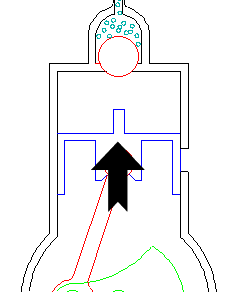
Torque returns the piston to the top to complete the cycle.
Rocket and turbojet engines, according to the author, are striking in their design, but the animation of their work in his opinion is too boring.

The rocket engine is the simplest of its family, so let's start with it.
In order to function in open space, rocket engines require a supply of oxygen for their work, just like fuel. The oxygen-fuel mixture is injected into the combustion chamber where it burns continuously. High pressure gas escapes through the nozzles, causing cravings in the opposite direction.
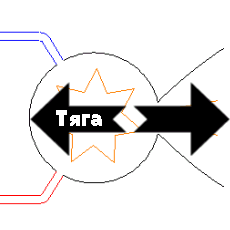
To test this principle yourself, inflate a toy ball and release it from your hands - the rocket engine works almost the same;)

A turbojet engine works on the same principle as a rocket engine, with the only peculiarity that it takes the oxygen needed for combustion from the atmosphere. By design, it is most effective at high altitudes with discharged air.
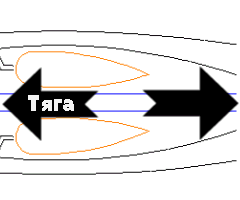
The moment of similarity: the fuel is continuously burned in the combustion chamber as in the rocket. The expanded gas leaves the combustion chamber through the nozzles, forming thrust in the opposite direction.

Differences: On its way out of the nozzle, a certain amount of gas pressure is used to spin the turbine. A turbine is a series of screws connected by a single shaft. Between each pair of screws is a stator (compressor guide). This unit helps gas flow through propeller blades more efficiently.

In front of the engine, the turbine shaft spins the compressor. The compressor works similar to the turbine, only in the opposite direction. Its function is to increase the pressure of air entering the engine. The turbine pushes the air and the compressor sucks.
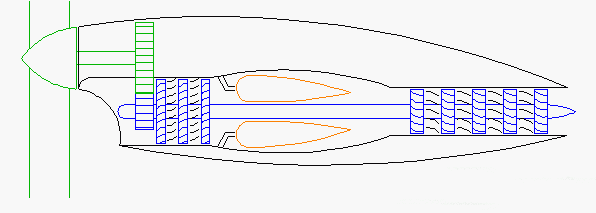
A turboprop engine is similar to a turbojet, with the only peculiarity that the gas leaving the combustion chamber rotates the turbine to a greater degree, which in turn rotates the propeller before the engine. He creates traction. Effective at low altitudes.
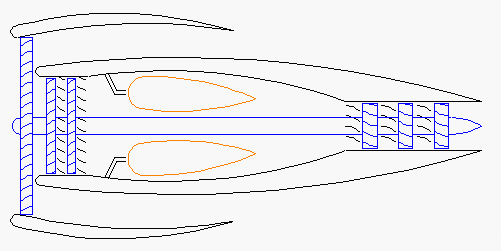
A turbofan engine is a sort of compromise between a turbojet and a turboprop. It works like a turbojet, but there is one feature: the turbine shaft rotates an external fan, which has more blades and turns faster than a propeller. This helps this engine to remain efficient at high altitudes, where air is polluted.
Sources:
www.animatedengines.com
UPD: Added Wankel and CO2 engines, they seemed to me the most interesting and practically useful.
UPD2: Added a description of a whole family of jet engines: rocket, turbojet, turboprop, turbofan.
And can you immediately explain to your girl how the gasoline engine differs from a diesel one? Four-stroke and two-stroke engines? Not? Then I invite under the cat.
')
Four-stroke engine
The working four-stroke engine was first introduced by the German engineer Nikolaus Otto in 1876, since then it is also known as the Otto cycle. But it is still more correct to call it a four-stroke. The four-stroke engine is probably one of the most common types of engines in our time. It is used in almost all cars and trucks.

Under the four cycles are meant: intake , compression , stroke , and release . Each stroke corresponds to one piston stroke, as a result of which the working process in each of the cylinders takes place in two revolutions of the crankshaft.
Inlet

During intake, the piston moves downward, pulling in a fresh portion of the air-fuel mixture through the intake valve. A distinctive feature of the engine in question is that the intake valve opens due to the vacuum generated by the downward movement of the piston.
Compression

Torque raises the piston, and that in turn compresses the air-fuel mixture. The inlet valve closes with increasing pressure force resulting from the piston lift.
Working stroke

At the top of the compression stroke, the spark ignites the compressed fuel. When fuel burns, energy is released that acts on the piston, causing it to move down.
Release

When the piston reaches its lowest point, the exhaust valve opens and the exhaust gases are expelled from the cylinder by a piston moving up.
Two stroke engine

In a two-stroke engine, the working process in each of the cylinders is performed in one revolution of the crankshaft, that is, in two strokes of the piston. Compression and working strokes in a two-stroke engine occur in the same way as in a four-stroke engine, but the processes of cleaning and filling the cylinder are combined and carried out not within individual cycles, but in a short time when the piston is near the bottom dead center, with the help of an auxiliary unit - purge pump. Wiki
Since in a two-stroke engine, each stroke of the crankshaft has one working stroke - two-stroke engines are always more powerful than four-stroke engines (if we take engines of the same volume). An important factor in favor of the former is their simpler and lighter design. These engines are widely used in benzo-saws, outboard motors, snowmobiles, light motorcycles and aircraft models.
Indisputable drawbacks of this type of engines are their inefficiency, since a significant proportion of the fuel does not burn out and is emitted along with the exhaust gases.
Inlet

The air-fuel mixture is sucked into the crank chamber due to the vacuum that is created during the upward movement of the piston.
Compression in the combustion chamber

During compression, the intake valve closes with pressure in the crank chamber. The fuel mixture is compressed at the final stage of the stroke.
Movement of the fuel mixture / release

Toward the end of the stroke, the piston forces the compressed air-fuel mixture to move through the intake passage from the crank chamber to the master cylinder. The air-fuel mixture displaces exhaust gases that leave the master cylinder through an exhaust valve. Unfortunately, the cylinder also leaves a certain amount of unburned fuel, which is why the two-stroke engine design is considered less economical.
Compression

After which the piston rises, driven by torque, and compresses the fuel mixture. (At this point, the next intake stroke occurs under the piston).
Working stroke

At the top of the bar, the spark plug ignites the fuel mixture. The energy generated causes the piston to move downward until the end of the cycle. (At this moment at the bottom of the cylinder, the fuel is compressed in the crank chamber).
Four-stroke diesel engine
A feature of the diesel engine is a modified fuel ignition system.
Having created his own type of engine in 1897, Rudolf Diesel declared that his engine is the most efficient engine ever made. Until now, his brainchild is among the most economical engines.
Inlet

The inlet valve opens and fresh air (without fuel) is sucked into the cylinder.
Compression

When the piston rises, the air is compressed and the temperature in the cylinder rises. At the end of the stroke, the air becomes hot so that the temperature becomes sufficient for the ignition of the fuel.
Injection

Near the top of the compression stroke, the fuel injector injects fuel into the cylinder. Contact with hot air ignites the fuel.
Working stroke

When fuel burns, energy is released that acts on the piston, causing it to move down.
Release

The exhaust valve opens, forcing the exhaust gases to leave the cylinder.
Rotary piston internal combustion engine (Wankel engine)

Wankel's rotary-piston engine is an amazing creation, offering a very intricate re-planning of four Otto cycle cycles. It was developed by Felix Wankel in the 50s of the last century.
In a Wankel engine, a trihedral rotor with a ring gear rotates around a fixed gear shaft in an elongated chamber.
Nowadays, Mazda is making the greatest efforts to develop and promote this type of engine, but the four-stroke engine remains the most popular. AvtoVAZ also uses this type of engine in autogyros .
- Advantages over conventional gasoline engines:
- low vibration. The rotor-piston engine is fully mechanically balanced, which allows to increase the comfort of light vehicles such as microcars, motorcars and unicars
- The main advantage of a rotary-piston engine is its excellent dynamic performance: in low gear, it is possible to overclock a car above 100 km / h without excessive engine load at higher engine speeds (8000 rpm and more) than in the case of a conventional piston internal combustion engine .
- High power density (hp / kg), reasons:
- smaller in 1,5-2 times overall dimensions.
- 35-40% less parts
- Disadvantages :
- Quick wear
- Overheating tendencies
- Production difficulty
- Lower cost at low revs
Inlet

The air-fuel mixture flows through the intake valve at this stage of rotation.
Compression

The fuel mixture is compressed here.
Working stroke

Working stroke, the fuel mixture is ignited here, rotating the rotor in a circle.
Release

Exhaust fumes come out here.
CO 2 engine

This type of engine can be driven by steam, but more often it can be found in small models of airplanes, where it operates on compressed air or carbon dioxide.
This animation shows a CO2 tank. Compressed CO2 is a liquid that, when released, goes into a gaseous state or in other words - at normal atmospheric temperature and pressure, liquid carbon dioxide boils, therefore we will not be mistaken if we say that this type of engine works for a couple of CO2.
Inlet

At the top of the cycle, the piston pin presses against the ball valve to admit high-pressure gas to the cylinder.
Working stroke

Gas expands moving piston down
Release

When the piston opens the exhaust valve, the pressurized gas leaves the cylinder.
Ending

Torque returns the piston to the top to complete the cycle.
Jet engines
Rocket and turbojet engines, according to the author, are striking in their design, but the animation of their work in his opinion is too boring.
Rocket engine

The rocket engine is the simplest of its family, so let's start with it.
In order to function in open space, rocket engines require a supply of oxygen for their work, just like fuel. The oxygen-fuel mixture is injected into the combustion chamber where it burns continuously. High pressure gas escapes through the nozzles, causing cravings in the opposite direction.

To test this principle yourself, inflate a toy ball and release it from your hands - the rocket engine works almost the same;)
Turbojet

A turbojet engine works on the same principle as a rocket engine, with the only peculiarity that it takes the oxygen needed for combustion from the atmosphere. By design, it is most effective at high altitudes with discharged air.

The moment of similarity: the fuel is continuously burned in the combustion chamber as in the rocket. The expanded gas leaves the combustion chamber through the nozzles, forming thrust in the opposite direction.

Differences: On its way out of the nozzle, a certain amount of gas pressure is used to spin the turbine. A turbine is a series of screws connected by a single shaft. Between each pair of screws is a stator (compressor guide). This unit helps gas flow through propeller blades more efficiently.

In front of the engine, the turbine shaft spins the compressor. The compressor works similar to the turbine, only in the opposite direction. Its function is to increase the pressure of air entering the engine. The turbine pushes the air and the compressor sucks.
Turboprop

A turboprop engine is similar to a turbojet, with the only peculiarity that the gas leaving the combustion chamber rotates the turbine to a greater degree, which in turn rotates the propeller before the engine. He creates traction. Effective at low altitudes.
Turbofan engine

A turbofan engine is a sort of compromise between a turbojet and a turboprop. It works like a turbojet, but there is one feature: the turbine shaft rotates an external fan, which has more blades and turns faster than a propeller. This helps this engine to remain efficient at high altitudes, where air is polluted.
Sources:
www.animatedengines.com
- Ultimate Visual Dictionary, 1999 DK Publishing Inc.
- Building the Atkinson Cycle Engine, Vincent Gingery, David J Gingery Publishing, 1996
- The Stirling Engine Manual, James G. Rizzo, Camden Miniature Steam Services, 1995
- Modern Locomotive Construction, JGA Meyer, 1892, reprinted by Lindsay Publications Inc., 1994
- Five Hundred and Seven Mechanical Movements, Henry T. Brown, 1896, reprinted by The Astragal Press, 1995
- Model Machines / Replica Steam Models, Marlyn Hadley, Model Machine Co., 1999
- Air Board Technical Notes, RAF Air Board, 1917, reprinted by Camden Miniature Steam Services, 1997
- Internal Fire, Lyle Cummins, Carnot Press, 1976
- Toyota Web site Prius specifications
- Steam and Stirling Engines you can build, book 2, various authors, Village Press, 1994
- Knight's New American Mechanical Dictionary, Supplement Edward H. Knight, AM, LL. D., Houghton, Mifflin and Company, 1884
- Thomas Newcomen, The Prehistory of the Steam Engine LTC Rolt, David and Charles Limited, 1963
- Low Temperature Differential Stirling Engines James R. Senft, Moriya Press, 1996
- Anne to Stirling Engines James R. Senft, Moriya Press, 1993
UPD: Added Wankel and CO2 engines, they seemed to me the most interesting and practically useful.
UPD2: Added a description of a whole family of jet engines: rocket, turbojet, turboprop, turbofan.
Source: https://habr.com/ru/post/138370/
All Articles